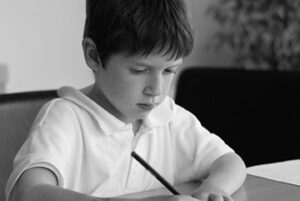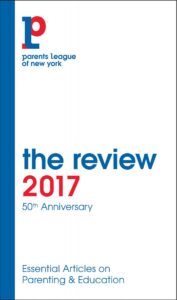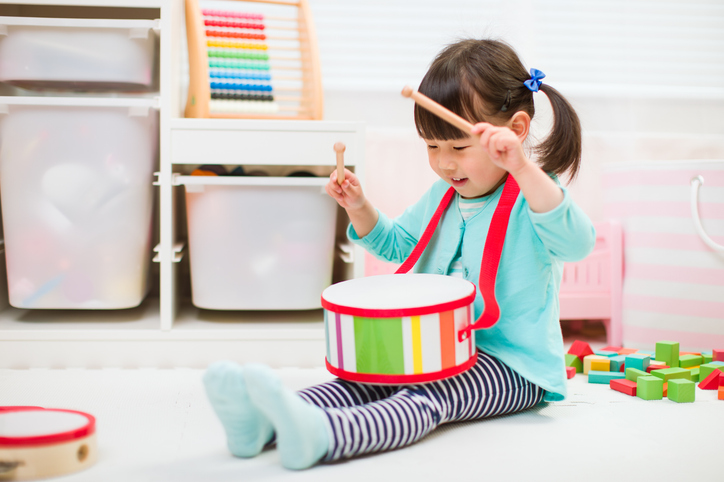Practice Makes Perfect

When my students take tests or quizzes, I like to walk around the room to check on their progress, ensure they understand my questions, and whisper encouragement where it’s needed. I read their body language and watch them respond to the challenge of particularly difficult sections. In these unguarded moments, I see their mindsets laid bare: some attack the assessment with bravado and glee, eager for the challenge. Others come to the page with hesitation and concern, in doubt of their abilities or second-guessing their preparation.
One such day a few years ago, I was making my rounds and noticed an eighth-grade boy (I will call him Adam) hunched over his Latin test with the unmistakable rigidity and posture of fear. His hand hovered over the blank white space under question two, shaking in midair. I placed my hand gently on his shoulder, leaned down, and whispered,
“Adam, just move on to the next question; you can always come back to it later on.”
He looked up at me, his face tense with anxiety, and said,
“I can’t.”
This was not hyperbole; Adam was frozen, absolutely unable to move on to question three while question two remained less than perfect, let alone blank.
The Expectation of Perfection
In a recent poll conducted by the National Society for the Prevention of Cruelty to Children, a U.K.-based children’s charity, the phrase “practice makes perfect” ranked as the most influential bit of wisdom adults hand down to children. Intended to mean that one can’t perfect a skill without repeated, dogged practice, the aphorism has come to mean something very different to my students than it did to the children of earlier generations. Where once the word “practice” was the operative word in the phrase, now “perfect” has eclipsed it in importance and emphasis.
Sadly, my students’ intellectual bravery has collapsed under the suffocating and constant burden of perfection. Practice has become little more than the unfortunate and shameful first attempts they must endure in order to achieve the perfect end everyone expects of them. Its products are, in their minds, the ugly detritus of learning—best kept locked away behind closed doors.
For many students, and certainly for Adam, perfect is no longer a Platonic ideal. In a year in which the national news featured students admitted to all eight Ivy League schools, perfection has become a baseline expectation, and kids like Adam, who buy into this expectation, suffer anxiety, depression, anger and body image issues as they endure the weight of unrealistic, unbearable standards.
As Adam stared at question two, he was stuck in the belief that perfect was required, not just on this question, but every day, in every thing he did, lest he be revealed as an imposter to his parents, classmates, teachers and, worse, to himself.
A Mindset Death Spiral
As readers of Carol Dweck know, my frozen student was stuck in the death spiral of his fixed mindset. A fixed mindset (the belief that we are the result of our labels—smart, disabled, genius, stupid, gifted) is not only the bane of a teacher’s existence, but it results in an intellectual and emotional purgatory for a student. Kids with growth mindsets, on the other hand, understand that intelligence is a matter of “it depends,” the product of effort, pushing through temporary frustration into durable understanding, and the ongoing, lifelong process of becoming smarter. My student was hopelessly mired in a fixed, inflexible mindset, and that imperfectly answered question was proof positive of his flaws, hard evidence that he was not the smart and talented kid his parents and teachers had been praising since birth. If left unanswered, he was that question—blank, empty, and just plain wrong.
Children increasingly confuse what Martin M. Antony, a psychology professor and author of When Perfect Isn’t Good Enough and co-author of Cognitive Behavioral Treatment of Perfectionism, refers to as healthy and “appropriately high standards” with unhealthy “perfectionistic beliefs.”
The line between appropriately high standards and an unhealthy adherence to a perfect ideal is hard to pinpoint, but Dr. Antony delineates that line in terms of flexibility. In Dr. Antony’s words, “[T]he more inflexible your beliefs are and the more situations in which you have inflexible opinions, the more likely you are to run into problems. This is particularly true in situations where your beliefs are arbitrary and subjective rather than based on facts or hard evidence opinions.” Over the nearly two decades I have been teaching, I’m seeing more and more intractable, unhealthy inflexibility in my classroom, and, as a result, much less experimentation, emotional bravery, and the sort of leaps of faith that result in intellectual breakthroughs.

Fear of Messy and Imperfect
And oh, the opportunities that are lost to this inflexibility and the constant pursuit of perfection. As a writer and teacher, I am well aware that the best writing comes from draft after draft of drivel, sentences embarrassing and horrifying in their mixed metaphors, flawed logic and dead-end ideas. These first efforts at forming ideas into text, what Stephen King refers to as the drafts you write behind a closed door, are an essential part of the writing process. I’ve spent days writing words that led nowhere—save to a slightly better second draft—and it’s taken me years to learn that in order to get to something good, I have to write a lot of bad.
Unfortunately, the pursuit of constant perfection means that my students are increasingly afraid of these messy, imperfect first attempts, as if they are convinced the contents of their brains and character will be forever tied to these flawed sentences. The author Anne Lamott calls the messy and imperfect first draft “the child’s draft, where you let it all pour out and then let it romp all over the place.” However, as children become more afraid of rough drafts in all their imperfection, not even children are writing these “child’s drafts” anymore.
I once had the opportunity to interview Stephen King, one of the most prolific writers in history, for The Atlantic. King was a high school English teacher years ago, and he speaks fondly of his days teaching kids, “even the Beavis and Butt-Head types.” I wanted to pick his brains and find out how he engaged his students in writing. Specifically, I wanted advice about how to help my students return to the joy of a child’s draft, to understand the importance of closed-door writing, and to transcend their fear of looking stupid or incompetent:
Lahey: You extol the benefits of writing first drafts with the door closed, but students are often so focused on giving teachers what they want and afraid of making mistakes that they become paralyzed. How can teachers encourage kids to close the door and write without fear?
King: In a class situation, this is very, very hard. That fearlessness always comes when a kid is writing for himself, and almost never when doing directed writing for the grade (unless you get one of those rare fearless kids who’s totally confident). The best thing—maybe the only thing—is to tell the student that telling the truth is the most important thing, much more important than the grammar. I would say, “The truth is always eloquent.” To which they would respond, “Mr. King, what does eloquent mean?”
King’s answer, that truth is more important than perfection, has changed the way I parent and teach.
For the seventeen years I’ve been teaching, I taught my students and my children to view the end product—an essay, a test, a magic wand whittled out of an old tree branch—as tangible proof of learning. However, I’ve come to understand (and I hope I have helped my students and children understand) that this end product is just one stage of their progress; no more or less important than the mistakes they discarded along the way. The draft that ended up in the recycling bin contained two sentences that were key to developing what is now the thesis of a beautiful final draft. The broken wand in the kindling box provided a lesson in wood’s tensile strength. These discoveries that masquerade as mistakes are harder to grade, to be sure, but they are essential, and I try to grant them their own, inherent value in the eyes of my students.
Sharing Truths
The most important thing I do, however, to help my students remain flexible is to value the truth.
The truth is, we all fail in our early attempts at perfection, and while I’d love to keep all of those embarrassing stories behind closed doors with my discarded rough drafts, I can’t. Those stories of failure are evidence of my flaws, yes, but they are also evidence of my hard work, resilience and fortitude. Consequently, my students and my children have heard my truths; they know I nearly failed Civil Procedure in my first year of law school due to a failure on my part to understand the vital importance of practice exams. They know I can’t dance, mainly because of a discomfort with my obvious lack of grace. They know about my goals and my dreams, and what I’ve done, both right and wrong, to achieve them. I have shared my truth with them, and in return, they are much more likely to allow me to witness theirs.
And so, when Adam admitted he was unable to move on, I did not save him from his discomfort or his struggle. That was his truth to face. I moved on to the next student, and the next, and so on down the row. As difficult as that day was for him, it was an important part of his journey. Over the next year, thanks to honest conversations, support from his parents and extra help at school, he managed to regain some flexibility and a sense of perspective over his perfectionism. He continues to maintain perspective on the difference between appropriately high standards and unhealthy beliefs.
Children, if no one else, should be able to write a child’s draft. Learning should be a process of trying and failing, of letting it all pour out, and allowing our truths—the ugly mistakes and the moments of perfection—romp all over the place.
Jessica Lahey is an educator and writer. She is a columnist for The New York Times, a contributor to The Atlantic, and a commentator for Vermont Public Radio. She is the author of The Gift of Failure: How the Best Parents Learn to Let Go So Their Children Can Succeed.

This article first appeared in the 2016 issue of the Parents League Review. Get the current issue of the Review free with a family membership. Or purchase it separately.












